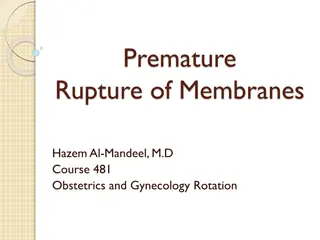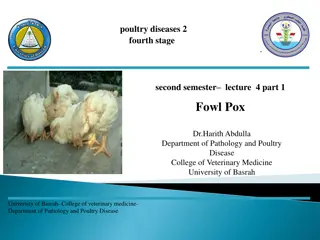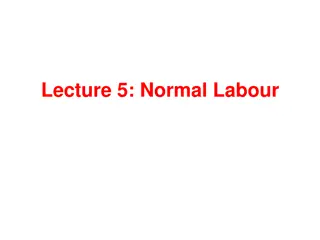Clinical Diagnosis and Assessment of Pre-Labour Rupture of the Membranes
Pre-Labour Rupture of the Membranes (RROM) is characterized by the leakage of amniotic fluid before the onset of labor, particularly when the gestational age is less than 37 weeks. Clinical diagnosis involves a thorough history evaluation and examination, including sterile speculum examination to confirm the presence of amniotic fluid. Additional assessments such as ultrasound, cervical cultures, and specialized tests like Fetal Fibronectin can provide valuable information for managing preterm PROM cases. Amniocentesis is also mentioned as a potential diagnostic tool. Prompt and accurate diagnosis is crucial for the appropriate management of preterm RROM.
Download Presentation

Please find below an Image/Link to download the presentation.
The content on the website is provided AS IS for your information and personal use only. It may not be sold, licensed, or shared on other websites without obtaining consent from the author.If you encounter any issues during the download, it is possible that the publisher has removed the file from their server.
You are allowed to download the files provided on this website for personal or commercial use, subject to the condition that they are used lawfully. All files are the property of their respective owners.
The content on the website is provided AS IS for your information and personal use only. It may not be sold, licensed, or shared on other websites without obtaining consent from the author.
E N D
Presentation Transcript
Pre-Labour Rupture of the Membranes Dr. Zina Abdullah
PRE-LABOUR RUPTURE OF THE MEMBRANES (RROM) Defined as rupture of membranes with leakage of amniotic fluid in the absence of uterine activity or before the onset of labour. When the gestational age is less than 37 wks we call it preterm (RROM) (preterm, pre labour rupture of membrane). INCIDENCE. Term PROM occur in 8% while preterm PROM occurs in2- 3%
Clinical diagnosis&assessment. 1. HISTORY. SYMPTOMS ARE THE KEY TO DIAGNOSIS; THE PATIENT USUALLY REPORTS A SUDDEN GUSH OF FLUID (WATERY VAGINAL DISCHARGE) OR CONTINUED LEAKAGE. 2.EXAMINATION (WORK UP) STERILE SPECULUM EXAMINATION IS NECESSARY TO CONFIRM THE DIAGNOSIS FOR DIRECT VISUALIZATION OF LEAKAGE; FERNING; AND NITRAZINE TESTS. PROM SHOULD BE CONFIRMED BY STERILE SPECULUM EXAMINATION PERFORMED AFTER THE MOTHER HAS RESTED SUPINE FOR 20-30 MINUTES. AMNIOTIC FLUID SHOULD BE SEEN POOLING IN THE POSTERIOR FORNIX. THE EXAMINER SHOULD LOOK FOR THE 3 HALLMARK CONFIRMATORY FINDINGS ASSOCIATED WITH PROM: 1. POOLING 2. NITRAZINE TEST 3. FERRING
Fluid from the posterior fornix is placed on a slide and allowed to air-dry. Amniotic fluid will form a fernlike pattern of crystallization. A digital exam (pv) should be avoided unless the patient is thought to be in established labor as it is known to be increased incidence of: -Chorioamnionitis. -Postpartum endometritis. -Neonatal infection. 4. Ultrasound (U/S):- should evaluate the amniotic fluid. The amniotic fluid volume (usually measured by deepest vertical pocket [DVP] or amniotic fluid index [AFI] . may be useful additional investigation in those women with strong history of PROM .In addition U/S is useful to assess the fetal presentation, biometry for gestational age, anatomy, placenta and cord location 5. Cervical cultures including chlamydia trachomatis and neisseria gonorrhoeae is indicated especially in high risk group 6.Group B streptococcus (GBS) culture should be sent from ano-rectal and vaginal areas.
7.Specialized tests Vaginal swabs for: A. (Fetal fibronectin): -it is a glycoprotein present in large amount in the amniotic fluid. It can be detected in the endocervix or the vagina of patient with PROM by (ELIZA). B. (Insulin-like growth factor binding protein 1) (IGFBP1) C. ( HCG). All the above three presents in high concentration in the amniotic fluid and have available rapid bedside tests
8. Amniocentesis can be of use for the evaluation of: A) the diagnosis. If diagnosis is in doubt, 1 ml of indigo carmine in 9 ml of normal saline can be injected into the amniotic cavity under continuous ultrasound guidance presence of blue on a pad worn on the perineum. B)the infectious state of the amniotic cavity. Send amniotic fluid glucose (< 15 mg/dl associated with positive culture),gram stain, and culture. C) the fetal lung maturity. Results of similar accuracy to amniocentesis can be obtained non-invasively by collecting vaginal fluid using a bedpan
COMPLICATIONS OF PROM: 1.Infection 2.(PPROM) include: premature labor/delivery with related complications of prematurity such as (a) respiratory distress syndrome or (RDS). (B) intraventricular hemorrhage (IVH) . (c)periventricular leukomalacia (PVL). (D)infection and necrotizing enterocolitis (NEC). 3.Abruptio placenta 4.Fetal distress: - variable deceleration may occur due to cord compression
Complications especially for PPROM < 24 weeks include: 5. Perinatal death. 6. Pulmonary hypoplasia is frequent when PROM occurs before 26wk. & The latent period prolonged for > 5weeks. 7. Compression deformities facial & skeletal deformities may occur with prolonged PROM. 8. Long-term infant morbidities. 9.Increased need for cesarean delivery. 10. Retained placenta.
Management of patient with PROM: Management of PPROM continues to be controversial. However, many obstetricians will institute conservative management in PPROM before 34 weeks and would induce labour relatively early in women whose membrane rupture occurs subsequent to 37 weeks. There is currently no good evidence as to what ideal management should be between 34 and 37 weeks. *Determination of gestational age: - TERM PROM. The interval between prom and onset of spontaneous labor (latent period) and delivery varies inversely with gestational age. At term, > 90% of women with PROM begin labor within 24 h; at 32 to 34 wk, mean latency period is about 4 days The term pregnancy (EGA= or greater than 37 weeks) with PROM in the absence of infection can be managed expectantly or actively. Expectant management entails non-intervention while waiting for the patient to go into labor spontaneously, whereas active management entails induction of labor with an agent such as oxytocin (pitocin). Nonintervention is an acceptable initial course of treatment, but if the patient does not go into labor within 6 12 hours after PROM, labor should be induced to minimize the risk of infection.
Preterm PROM Identification of patient who requires delivery first group) 1. Patient in labour (frequent uterine contractions, cervix 100% effaced & 4cm dilated or more). 2.Mature fetal lung checked by amniocentesis ((by L/S ratio, phosphatidyl glycerol (PG)). 3. Fetal malformation (gross anomaly incompatible with life). 4. Fetal distress. 5. Patient with overt infection (patient with clinical chorioamnionitis should receive antibiotic before delivery inform of (ampicillin 2 g i.V. Q.D.S (4 times daily) & metronidazole 500 mg.I.V. T.D.S (3 times daily).
6. Patient with subclinical amnionitis. (Amniocentesis of gram stain & culture is accepted technique). 7. Patient at high risk for infection: - Pt. Taking immunosuppressant drugs. History of rheumatic heart dis. I DM. Sickle cell disease. Heart valve prosthesis. Who had several pelvic examinations since prom occur.
EXPECTANT MANAGEMENT: - In many units, women with a diagnosis of PPROM are admitted into hospital and managed conservatively until 37 completed weeks of gestation in an attempt to increase fetal lung maturity. Conservative management involves: 1. Admission to hospital & the woman's activity is limited to modified bed rest & complete pelvic rest with bath room privileges 2.Maternal surveillance. All women with PPROM should be monitored for signs and symptoms of infection by: *Four-hourly measurements of maternal temperature, heart rate, respiratory rate, and blood pressure. *Weekly maternal white cell counts, c-reactive protein assays, and lower genital tract swabs culture are routinely taken, all in an effort to detect intrauterine infection or chorioamnionitis
3.The fetal surveillance: the two most common types of fetal surveillance are NST and biophysical profile (BPP). Abnormalities of these tests can be somewhat predictive of fetal infection and umbilical cord compression related to oligohydramnios. 4.Serial U/S for liquor volume & presentation weekly & growth every fortnight are arranged. 5.Antibiotics: the regimen studied by the national institute of child health and human development trial25uses an intravenous combination of 2 grams of ampicillin and 250 mg of erythromycin every six hours for 48 hours, followed by 250 mg of amoxicillin and 333 mg of erythromycin every eight hours for five days. Women given this combination were more likely to stay pregnant for three weeks despite discontinuation of the antibiotics after seven days. Co-amoxiclav is not recommended for women with pprom because of concerns about necrotizing enterocolitis.
6.Corticosteroids should be administered in women with PPROM at 2434 weeks, as this intervention is associated with lower incidences of RDS, IVH, NEC, and a trend for a lower neonatal death rate. They do not appear To increase the risk of infection in either mother or baby 7.Tocolysis may be used for women with PPROM and uterine activity who require intrauterine transfer or antenatal corticosteroids. Tocolysis is given 48 hours to allow administration of corticosteroids. 8.Amnioinfusion for prolonging latency: Trans abdominal amnioinfusion is not recommended as a method of preventing pulmonary hypoplasia in very preterm PPROM. 9. Use of fibrin glue. Fibrin sealants are not recommended as routine treatment for second-trimester oligohydramnios caused by PPROM. 10. Vitamin C and E.
Role of outpatient management In rare selected cases, patients who remain undelivered may be candidates for outpatient monitoring should be considered only after a period of 48 72 hours of inpatient observation .If leakage of fluid stops, the amniotic fluid volume normalizes, and the patient remains a febrile without evidence of increasing uterine irritability, she can be discharged home. These patients should be monitored very closely on an outpatient basis. They must be reliable and compliant with follow-up appointments. They also must take their temperature twice daily and be counseled on the warning signs of chorioamnionitis. These patients should also be monitored with frequent biophysical profiles; some sources recommend daily testing.
When is the appropriate time to deliver? Delivery should be considered at 34 weeks of gestation. Pregnancies beyond 34 weeks' ega can be managed as a term pregnancy because there is no evidence that antibiotics, corticosteroids, or tocolytics improve outcome in these patients. These patients can be managed expectantly as long as they show no signs of chorioamnionitis. Randomized trial have suggested that a policy of induction as opposed to expectant management may lead to less hospitalization, less perinatal infection and less neonatal morbidity .Where expectant management is considered beyond 34 weeks of gestation, women should be counselled about the increased risk of chorioamnionitis and its consequences.
Previable PROM bellow 23-24 weeks: there are significant risks of lethal pulmonary hypoplasia a condition that can't be reliably predicted on prenatal U/S additional risk include chronic pulmonary morbidity, fetal limb contractures , many parent will opt for termination of pregnancy.























